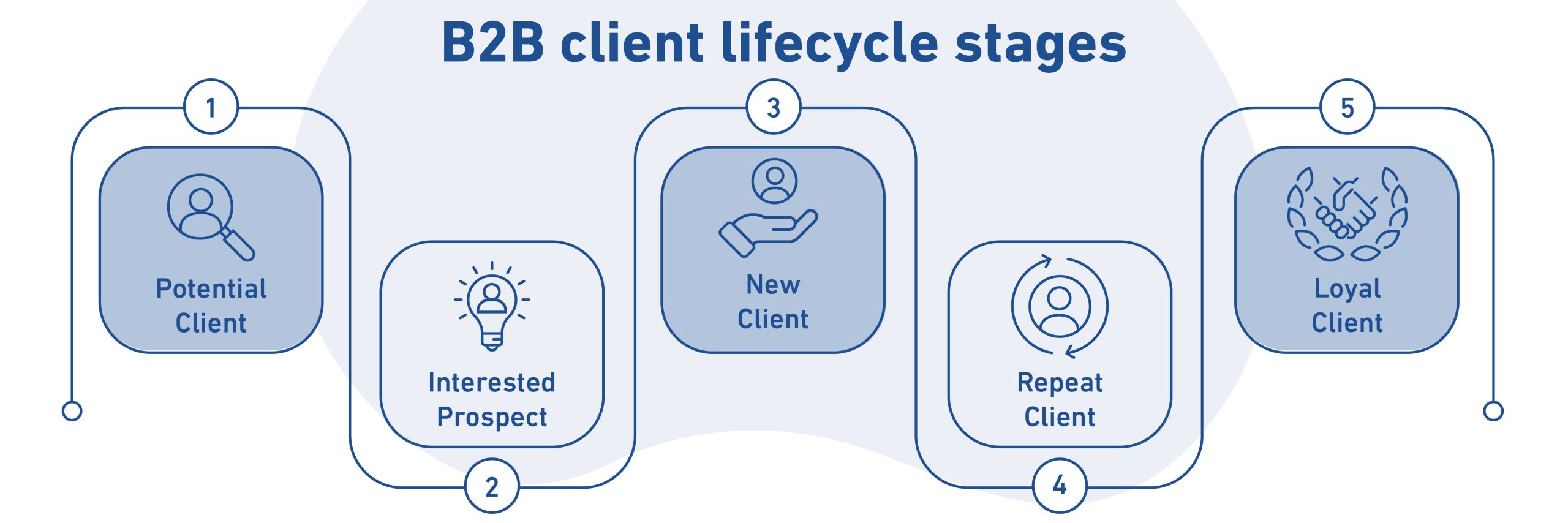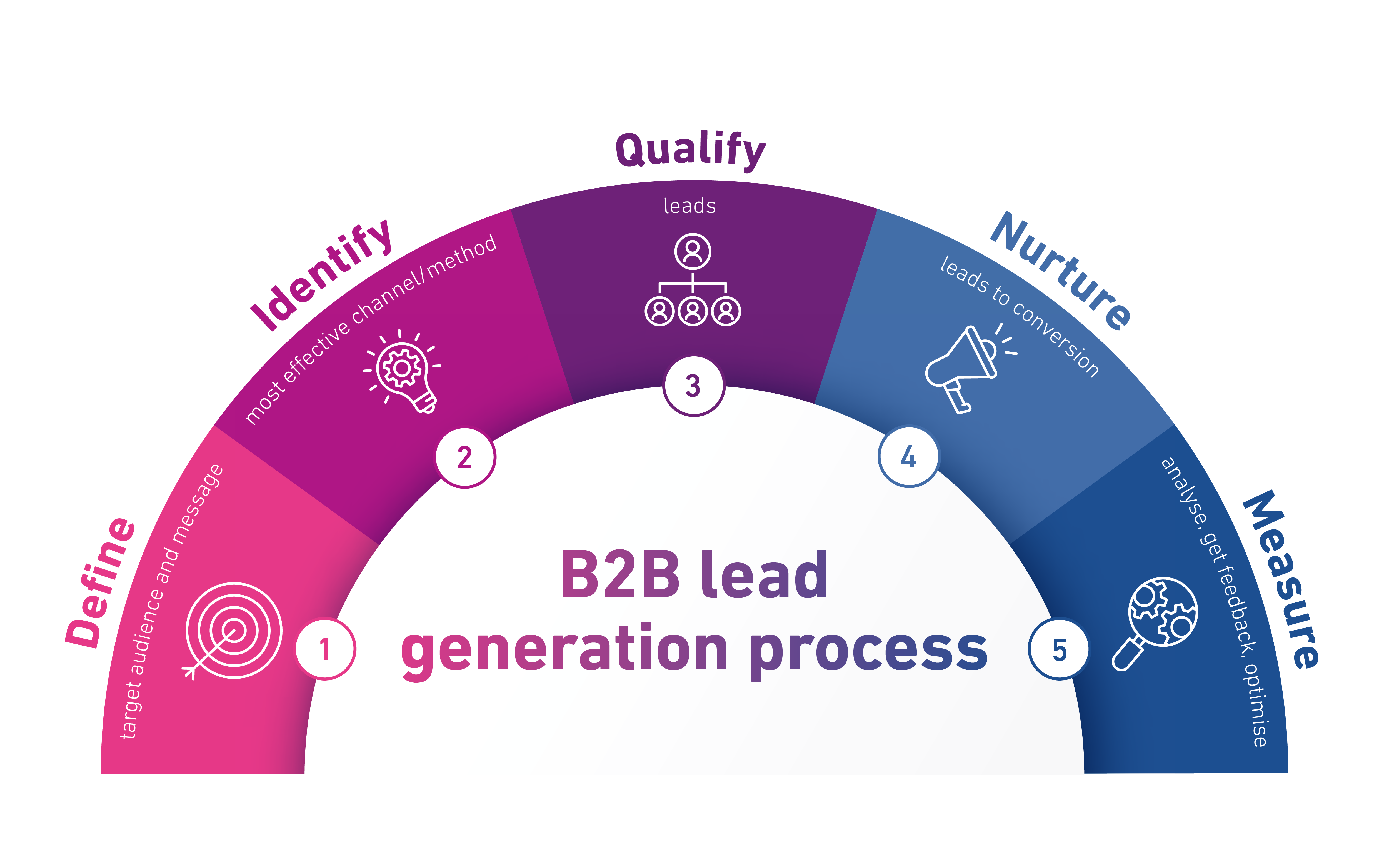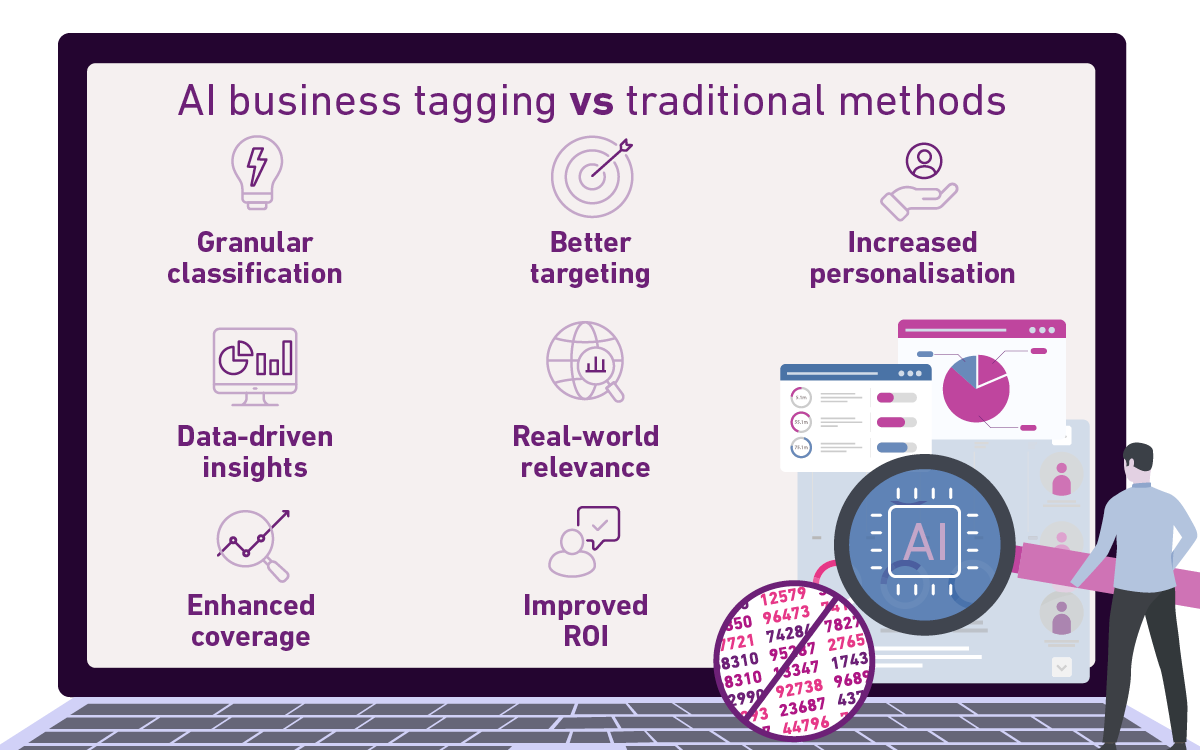Why does B2B lead generation matter?
B2B lead prospecting drives business growth by identifying potential customers. Effective lead generation goes beyond just finding clients or purchasing prospect lists – it builds lasting business relationships with clients by creating meaningful connections.
By understanding where prospects are in the customer lifecycle—from initial interest to loyal advocacy—businesses can refine their engagement strategies and ensure every interaction adds value.
Using data and advanced tools, businesses can target, qualify, and convert leads more efficiently, ultimately building stronger, long-term relationships and driving business growth.
The client lifecycle
A business relationship typically progresses through several stages, collectively referred to as the customer life cycle. While these stages can be described in various ways, they generally include the following:

- Potential client: A business or organisation that hasn’t yet interacted with your company but meets your target market criteria.
- Interested prospect: A business or organisation that has become aware of your company and shown interest in learning more—your leads!
- New client: A business or organisation that has made its first purchase or engaged your services.
- Repeat client: A business or organisation that has made multiple purchases or engaged your services on several occasions.
- Loyal client: A business or organisation that is highly satisfied with your offerings and actively recommends your company to others.
Lead generation is the process of introducing your business to potential clients and nurturing them into interested prospects—your leads—who are primed for further engagement.
The importance of data throughout the B2B sales cycle
Data is a valuable asset at every stage of the B2B sales cycle. But it’s less about gathering large sales prospecting lists and more about ensuring the data you have is accurate, detailed, and aligned with your goals.
Key takeaway
By prioritising quality over quantity, you can focus effort on targeting well-qualified leads from the start, saving time and resources while improving your chances of success.
Customer insights data go beyond basic prospecting lists. By analysing the characteristics of your best clients, you can create detailed business personas. This enriched view enables you to refine your prospecting efforts, focusing on businesses most likely to convert into valuable clients.
Credit reporting of prospect lists
Credit reporting adds another layer of insight, helping you assess the financial health and stability of your prospects. This information allows you to mitigate risk by identifying businesses that may not be a good fit. For instance, are they consistently slow to pay? Or showing signs of financial strain? With these insights, you can make more informed decisions about where to invest your time and resources.
By verifying and understanding the businesses you’re engaging with, high-quality data strengthens your ability to assess their suitability within your client portfolio. Remember, however, that collecting data from a reputable, quality data provider is just as important as having data in the first place.
A step-by-step process to generate B2B leads
Successful B2B lead generation is a strategic approach that combines clear messaging, the right tools, and high-quality data. By following a structured approach, you can attract, qualify, and convert valuable B2B leads efficiently, helping your business grow and thrive.
 Step 1: Define your target audience and message
Step 1: Define your target audience and message
The first step in effective lead generation is to understand who your target audience is and how to connect with them. Think about things like their industry, company size, goals, and challenges to make sure your outreach resonates with the right businesses.
Step 2: Identify the most effective channel for your business method
Now that you know who you want to target, you need to decide how best to connect with them. Here are some effective methods for B2B lead generation:
Email marketing
Engage with prospects through email campaigns to build relationships and awareness over time
Direct mail
Reach out to potential clients doorsteps and desks with promotional material to see if you can garner interest
Telemarketing (cold calling)
It can be especially fruitful to follow up on direct marketing and and email campaigns with a phone call to further introduce your business
Social media
Share valuable content across the platforms your target clients are present on and engage with them
Paid ads
Use targeted ads on platforms like LinkedIn and Google to reach specific groups
Content creation
Share helpful content, like blogs, whitepapers, or case studies, to build trust, attract leads and drive traffic through search engines
Networking and events
Attend industry conferences and trade shows, and organise webinars or live events to showcase expertise
Promotions and giveaways
Offer free trials, discounts, or special deals to entice prospects to try your service or product
Step 3: Qualify your leads
Not all leads are equal, and that’s where data can help you. After generating leads, it’s important to analyse the raw data to see whether they match your ideal customer profile. Here you want to take into account factors such as engagement with your content, interest in your offerings, and their business’s financial health. Use basic credit and risk scores to assess business potential and prioritise leads that are not only likely to convert, but also look to have sound financial basis for growth.
Step 4: Nurture leads to conversion
Once you’ve qualified your leads, it’s time to nurture them:
- Find out how they prefer to be contacted and make sure to only reach out to them that way
- Understand the type of content they engage with and keep them interested by showing you know their needs and how to help.
- Use social proof, such as testimonials, to build trust and move leads closer to making a decision.
If time resource is an issue for your business, consider how marketing automation tools can help streamline the follow-up process.
Step 5: Measure, analyse, get feedback and optimise
Lead generation is an ongoing process. Track KPIs like response rates, conversion rates, and ROI to measure your efforts’ effectiveness. Use analytics tools to identify areas for improvement and optimise campaigns. Regular feedback and adjustments will refine your strategies, helping you generate higher-quality leads over time.
By following this approach, you’ll be able to attract quality B2B leads, build strong relationships with them, and turn them into long-term clients. Whether it’s through targeted marketing, using data effectively, or refining your outreach, this process helps your business consistently bring in valuable leads.
Lead qualification and prospect quality
As mentioned, in B2B, successful lead generation isn’t just about the volume of leads – it’s about targeting the right businesses. Focusing on quality leads and the right contact not only saves time but also reduces risks and drives better outcomes.
Key takeaway
Quantity vs. quality
A smaller list of qualified leads, where we know that the business is genuinely live and trading, is much more valuable than a large list of prospects who may or may not fit your ideal client profile or be genuinely live and trading businesses.
How to distinguish quality leads
To identify the best leads, use a lead scoring system that helps you assess their value. Here are some key factors to consider:
- Ideal client persona: Does the lead match your target client profile?
- Audience research: Have you done the research to ensure your leads are a good fit for your product or service?
- Budget: Do they have the financial resources to invest in what you’re offering?
- Business health: Check their financial stability using credit reports and other insights. Are they financially solid and a reliable payer?
Key takeaway
Use data suppliers who can provide credit reports and financial insights. Remove businesses with poor credit performance to avoid risky leads and bad debt.
Feedback from sales teams
Sales teams are in direct contact with leads and can provide valuable feedback. Regularly check in with them to see what’s working and what’s not. This insight will help you refine your lead qualification process and ensure you’re targeting the right prospects going forward.
Overcoming lead generation challenges
Lead generation comes with its fair share of challenges, but with the right strategies, you can tackle them and see better results. By optimising your processes, leveraging high-quality data, and keeping your focus on ROI, you can overcome common obstacles and improve efficiency throughout your business.
Bottlenecks in lead generation: Lead generation can get stuck when processes aren’t running smoothly. Common roadblocks include outdated data and unclear targeting. To overcome these challenges, focus on automation and using enriched datasets. Automation tools can remove friction, simplify your workflow, and help your team work more efficiently, making sure each step in the process is effective.
Cost and ROI: One of the ongoing challenges in lead generation is balancing cost with return on investment (ROI). While investing in high-quality leads, like enriched data, may come with an upfront cost, it will ultimately yield higher returns. Keep a close eye on key performance metrics to adjust your budget and allocate resources where you’ll see the best results.
Lead scarcity in competitive markets: Finding quality leads in crowded, competitive markets can be daunting. However, narrowing your focus to specific niches within your target market can help uncover high-potential opportunities. You can identify businesses with the most growth potential through detailed insights delivered through powerful analytics and AI-infused research, allowing you to target in a personalised way to great effect, even in competitive spaces.
Ethics and Compliance: It’s important to make sure your data sources are reliable and trustworthy. By partnering with trusted data providers like Experian, you can keep your lead generation efforts ethical and compliant, ensuring your business stays protected and your customers’ trust is maintained.
Key takeaway
Avoid the risk of buying cheap prospecting lists from untrusted sources. Protect against costly inspections and expensive penalties by having certainty in a reputable provider with data that complies with ICO regulations.
Common mistakes and how to avoid them
Understanding common lead generation mistakes helps refine your approach and avoid setbacks. Here are some areas where businesses often get it wrong, and some strategies on how to avoid making the same mistakes:
Targeting the right person at the right level: To do this, you need to understand the business size and structure. In smaller companies, the Managing Director (MD) often handles all purchasing decisions, while in larger ones, specific roles like the Finance Director (FD) may be responsible for financial decisions or, say, the purchase of financial products and services.
For example, in a 100+ employee company, you’d target the FD, but in a smaller company, the MD might be your contact. Also, in large organisations with subsidiaries, decision-makers are often at the parent company, not the subsidiary. Enriched data, like Business Tags and company linkages, helps you identify the right businesses, the right contacts and the right opportunities by providing a clear view of the company’s structure, key decision-makers and areas of interest.
Inadequate buyer personas: Segmenting prospects into general categories may not provide the detailed insights needed to truly understand a business and its customers. This can then lead to:
- Inconsistent or unengaging messaging: When the message does not align with the motivations of the target businesses, it can make it hard to capture attention.
- Lack of personalisation: Generic or bland messaging that fails to address the unique challenges or needs of individual recipients can come across as impersonal and uninspired.
Poor data quality: Using expired or incomplete datasets wastes valuable resources. Keep your data fresh by regularly cleaning it, and partner with trusted providers who offer enriched insights. Make sure you target businesses that are actively trading – don’t trust Companies House to verify company status – and don’t overlook sole traders who aren’t listed on Companies House but still represent valuable leads.
Key takeaway
Regularly clean and improve your data, verify company statuses and add third-party insights to ensure you don’t waste time and effort on inefficient B2B prospecting.
Overlooking niche or emerging markets: Don’t overlook niche or emerging markets – they can hold untapped potential. By using enriched data, you can identify these high-growth sectors early on and tailor your strategy to address them. Standard Industry Classifications don’t evolve with these markets as quickly as AI-driven data (such as Experian’s Business Tags) can.
Siloing marketing and sales teams: Lack of collaboration between marketing and sales leads to missed opportunities. Align both teams by sharing goals, feedback, and insights to improve targeting, lead quality, and conversions.
Over-reliance on one channel: Relying on just one channel limits your reach. Maximise engagement by using a mix of email, social media, content marketing, and telemarketing.
Inadequate follow-up strategies: Without consistent follow-ups, leads can go cold. Create a structured follow-up plan with personalised, timely touchpoints and use automation to stay engaged throughout the buyer’s journey.
Not maximising sales enablement for sales teams: Sales teams need the right tools to succeed. Provide case studies, demos, testimonials, FAQs, and expert support to help them close deals and convert leads.
Not moving with the market: Market conditions constantly shift. For instance, many businesses are concerned about inflation, but research shows two in five businesses see an opportunity for increasing spend. Adjust your strategy to align with these market trends. Working with a data provider that offers enriched insights helps you identify businesses navigating these changes and allows you to pivot your approach.
Putting too much sales pressure on leads: High-pressure tactics can push leads away. Focus on building relationships over time with value-driven, personalised engagement for better long-term conversions.
Nurture, don’t push. We know the B2B buying cycle can move more slowly than B2C, so striking the balance between regular and unintrusive engagement and constant bombardment is vital.”
Gavin Morais, Product Manager for Business Information
Lack of transparency: Trust is built on transparency. Clearly communicate your services, pricing, and expectations from the start. Being open and honest minimises friction and helps establish stronger, more productive relationships with your leads. For example, at Experian we ensure our B2B data complies with all regulations and provides details about its data sources in our business information marketing transparency notice.
Using AI to transform business sales insights and targeting
AI is changing the game when it comes to lead generation. It’s able to sift through massive amounts of data—crawling 7 billion web pages each week—giving you real-time insights and helping uncover new businesses.
Unlike older tools like SIC codes, which group businesses into broad categories, AI can create more accurate, detailed classifications based on how businesses actually define themselves.
Experian BusinessView, for example, provides access to AI-led Business Tags, with over 40,000 unique tags and the ability to assign up to 10 tags per business, AI-led Business Tags allow to enable for much more precise targeting and personalised marketing.
Key features of AI-driven business tagging:
- Granular classification: Target specific industries with precision, even in niche areas.
- Enhanced coverage: Get comprehensive data across a wide range of sectors, from Finance and Education to more specialised categories like Golf Clubs or Psychologists.
- Real-world relevance: AI constantly adapts to the changing business landscape, uncovering opportunities that traditional methods often miss.
- Better targeting: With AI, your marketing campaigns can be more focused and accurate.
- Increased personalisation: Tailor your messaging to the specific needs and challenges of your audience.
- Data-driven insights: Leverage deep analytics and segmentation to make more informed decisions.
- Improved ROI: AI-driven insights lead to higher engagement and conversions, boosting the success of your campaigns.

Key takeaway
Traditional methods can’t keep up with the complexity of business classification in today’s market. By using AI-driven Business Tags, you can uncover hidden opportunities, stay ahead of trends, and make smarter business and marketing decisions. It’s not just about keeping up—it’s about thriving in a competitive world.
How can we help?
Experian’s BusinessView offers reliable, up-to-date business data you can trust. As a leading credit reference agency, we ensure GDPR compliance through legitimate interest and strict data sourcing, so you can confidently target the right leads.
With real-time updates and easy API integration, BusinessView keeps your database fresh and helps you connect with new businesses. Our consultative approach provides customised solutions to make your targeting more efficient and improve campaign effectiveness.
By choosing Experian, you get actionable insights backed by trusted data, enabling better personalisation, engagement, and ROI.
Learn more more about how Experian collects and manages our business information.
Speak to an expert
Find out how BusinessView can help to improve your campaign efficiencies and effectiveness.
Let's talk










